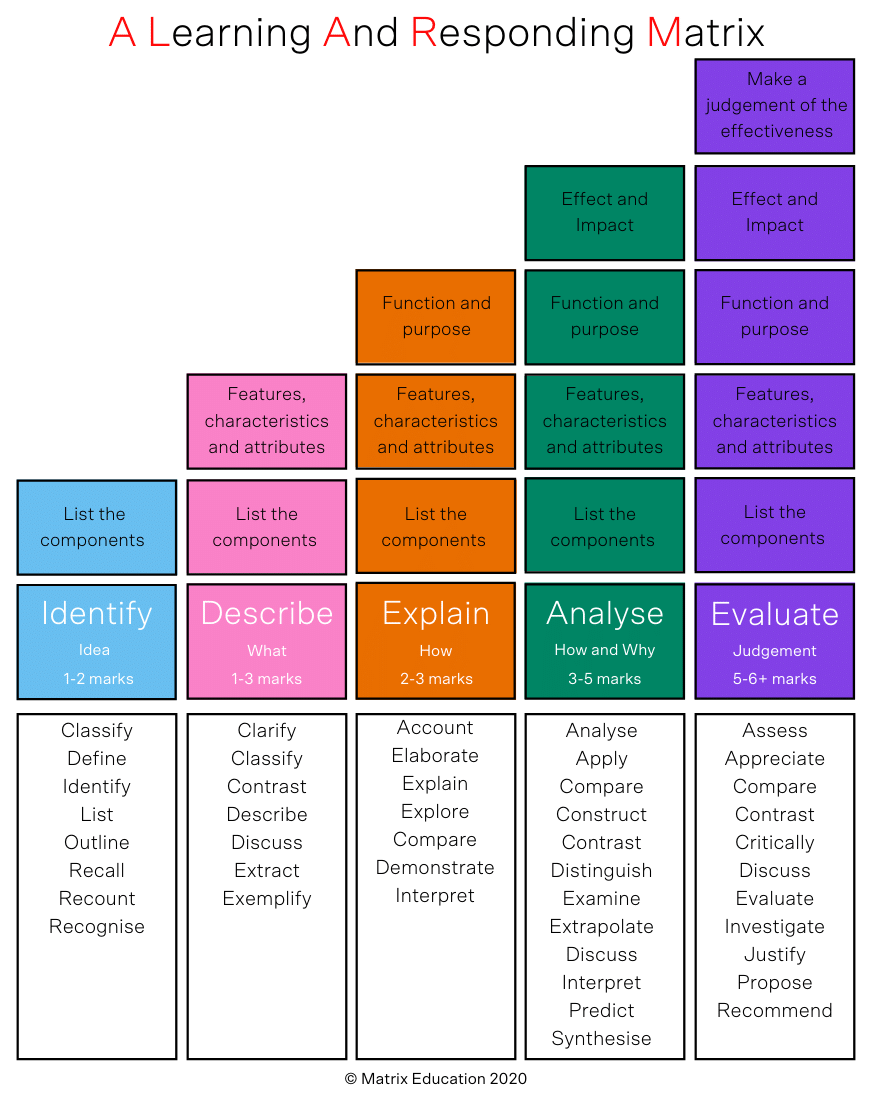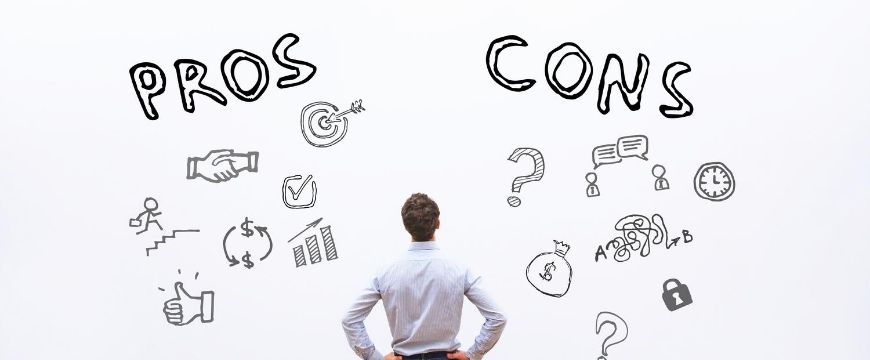So, you know about NESA’s list of “Key Words” but do you know why it is so important? The NESA Glossary of Key Words is an essential list of words that can crop up in your exams. The NESA Key Words are the imperative verbs that tell you how to respond to the given question or statement.
How to Respond to NESA Key Words to Ace Your HSC
The NESA key words are essential for all subjects. They are the instructional terms used by NESA to communicate what you are meant to do for a particular question. Knowing what each word is actually instructing you to do and how to respond to them is imperative if you want to perform well in the HSC.
In this article, we’ll discuss,
- Why the NESA Key Words are important
- Using Key Words to your advantage
- List of key words and ways to respond to them
- Study tips
Why do I need to know the NESA key words?
You don’t want to go into your exam and waste 20 minutes answering an ‘identify’ question… That’s because identify questions aren’t expecting you to go into detail about the topic, they just want you to quickly list your answer!
Each NESA key word requires you to demonstrate different levels of thinking and writing.
They are often an indicator of how much you should write, and the detail and sophistication of your answers.
So, remembering them will ensure that you can achieve full marks and allocate your time appropriately.
How can I use the key words?
The ALARM (A Learning and Responding Matrix) is a framework that helps you properly answer different types questions based on the NESA key words.
It categorises the key words into different ‘bands’.
So, key words that require more critical thinking and are more difficult to answer are placed on the far right, whereas key words that require a simple answer are placed on the far left.
Let’s take a closer look at the ALARM to see how it works.

ALARM: Use this matrix to help you answer your questions and achieve full marks.
You see, as we keep moving to the right, you are required to do more to fully answer the question.
Refer to the ALARM regularly and try to memorise each component. When you see the keyword in your question, recall the table and make sure you address each step to achieve full marks.
If you are struggling to recall a key word, take a look at the allocated marks. The number should give you an indication of whereabouts the keyword sits on the ALARM.
The NESA HSC key words and how to respond to them
NESA provides a glossary of key words and their definitions. We will go through these key words and show you how to answer them properly to achieve full marks.
Each subject will have slight variations on how you answer the same key word.
For example, ‘evaluate’ will be answered differently in Maths compared to English or Science. So, every time you come across these terms, remember to apply them to the subject.
Now that you know this, let’s get started and break down the key words! Remember, you should always recall the ALARM to help you figure out the components you need to satisfy.
| A | C | D | E | I | J | O | P | R | S |
| Account
Analyse Apply Appreciate Assess |
Calculate
Clarify Classify Compare Construct Contrast Critically (analyse/evaluate) |
Deduce
Define Describe Discuss Distinguish
|
Evaluate
Examine Explain Extract Extrapolate |
Identify
Interpret Investigate |
Justify | Outline | Predict
Propose |
Recall
Recommend Recount |
Summarise
Synthesise |
Account
Account for: state reasons for, report on.
Give an account of: narrate a series of events or transactions.
What does this really mean?
NESA uses account in three senses:
- Give the reasons for something occurring
- Provide a report on the topic
- Narrate the order of events/transactions happening
This keyword is usually used for humanities and science questions.
How do I respond to this?
1. Figure out which ‘account’ your question is asking you to answer
These elements will help you figure out which of the 3 purposes the question is asking you to do.
- Is it ‘account for’ or ‘give an account of’?
- What is the topic of the question?
- Consider the subject of the question
2. Figure out where ‘account’ belongs on the ALARM:
‘Account’ can belong in the ‘explain’ or ‘analyse’ category. This means that you need to:
- List the components
- Describe the characteristics of the components
- Provide examples
- Provide reasons: effects and impacts (if the question requires you to ‘give reasons for something occurring’)
3. Answer the question based on which 1 of the 3 definitions you are being asked:
- Reasons: Provide an explanation (why) for something occurring
- Report: Provide information (usually observations) about a topic
- Narrate order: Describe the events in order of it occurring
Analyse
Identify components and the relationship between them; draw out and relate implications.
What does this really mean?
The markers want you to explain how and why something is occurring by figuring out the relationship between the components.
This keyword is used for humanities subjects and science questions.
How do I respond to this?
1. Figure where ‘analyse’ stands on the ALARM
Analyse is part of the ‘analyse’ category. So you need to:
- Identify the components
- Describe its’ characteristics
- Provide examples
- Explain why: impact and effects
2. Break down the question and figure out the different components.
These are the different elements you need to figure out:
- Process: How does something work or function?
- Impact: How does it affect other components?
- Purpose: What is its significance?
So, you need to identify the different components, relate them with one another and figure out their impact/effect and significance.

Apply
Use, utilise, employ in a particular situation
What does this really mean?
Apply requires you to use the information/resources provided to you and show how it works in a different – but similar – situation.
You may be asked to ‘apply a formula’ to a Maths question or ‘apply a theory’ to a case study.
How do I respond to this?
1. Figure where ‘apply’ stands in the ALARM
Apply is an ‘analyse’ key word. This means that you need to:
- List the components
- Describe the features, attributes and characteristics
- Figure out the function and purpose
- Figure out the impact and effect
- Provide examples
2. Now, use the information/resource provided and show how it works in a different scenario:
- Briefly explain how the original information/resource works (i.e. explain the theory, formula etc.)
- This includes listing the components and describing the characteristics and function
- Now, show how this information/resource also works in a different situation
- Describe the new situation
- Explain how the original information/resource functions in the new situation
Appreciate
Make a judgement about the value of
What does this really mean?
You need demonstrate that you fully understand the implications of the topic and provide reasons to recognise why something is valuable or good.
This is what differentiates ‘appreciate’ from ‘assess’ or ‘evaluate’ because there are implications that the ‘thing’ is already of good value.
How do I respond to this?
1. Determine the components of ‘appreciate’ based on the ALARM
Appreciate is an evaluative term. This means that you need to:
- List the components
- Describe the characteristics
- Explain the function and purpose
- Provide examples
- Figure the effects and impacts
- Make a judgement of the value/effectiveness of the topic
Assess
Make a judgement of value, quality, outcomes, results or size
What does this really mean?
Assess requires you to make a judgement about something. There are a few things you can be asked to assess:
- Value: Useful/useless
- Quality: Good/bad, effective/ineffective
- Results: Whether or not a desired outcome is/can be achieved
- Size: The degree or magnitude of something
You don’t always need to make a clear cut decision about whether something effective or ineffective. You can place it on a relative scale. For example, something can be ‘somewhat useful’.
How do I respond to this?
Assess belongs to the ‘evaluate’ category. This means you need to:
- List the components
- Describe the characteristics
- Explain the function and purpose
- Figure the effects and impacts
- Make a judgement of the value/effectiveness of the topic
Calculate
Ascertain/determine from given facts, figures or information
What does this really mean?
Calculate requires you to use the facts, figures or information and do the maths to figure out the answer!
It is usually used in Maths and Science.
How do I respond to this?
Calculate is an ‘identify’ key word. So, all you need to do is do the Maths based on the facts, figures and information.
Remember to always show your working out to show the markers that you know how to get to the right answer.

Clarify
Make clear or plain
What does this really mean?
Clarify requires you to describe something in a clearer and more comprehensible way.
However, this isn’t an excuse to simplify your explanations. Instead, you have to break down the concept and try to make it easier to understand.
How do I respond to this?
1. Figure out where clarify sits on the ALARM
Clarify is a ‘describe’ term. So, you will have to:
- List the components
- Describe the characteristics, features and attributes
2. Break down the topic into components
To answer a ‘clarify’ question, you need to break down the topic into different components. Then, describe their features in a more comprehensible way.
This means that you need to target challenging areas of the topic and explain its features/process.
Classify
Arrange or include in classes/categories
What does this really mean?
Classify requires you to categorise ‘things’ into different groups based on their unifying traits.
How do I respond to this?
1. Figure out where classify sits on the ALARM
Classify is a ‘describe’ term. So, you need to know its:
- Components
- Features/characteristics/attributes
2. Determine it’s components, characteristics, features or attributes
Now, you need to identify and describe the different characteristics, features and attributes of the ‘thing’ you are being asked to classify.
3. Determine its category
After you described the ‘thing’, you need to figure out which category it belongs to. To do this, you need to have a good understanding of the characteristics of the category.
If the ‘thing’ satisfies the criteria of a particular category, then it is reasonable to classify it into that category.
4. Explain why the thing belongs in the category
It is important that you also describe the criteria of the category and compare it with the thing’s characteristics.
This is your explanation to support your classification.
Back to index
Compare
Show how things are similar or different
What does this really mean?
Compare means explaining how things are similar or different from one another.
It requires you to examine the different characteristics. Sometimes, you are required to dig deeper and examine the function and impacts of different things.
How do I respond to this?
1. Figure out where compare sits on the ALARM
Compare can be an ‘explain’ or an ‘analyse’ term. This means you need to:
- List the components
- Identify the features, characteristics and attributes
- Figure the purpose and function
- Figure the effect and impact
2. Identify the similarities and differences between things
You need to firstly identify the traits of the different things. To help, draw a table in your mind or in the margin.
3. Explain (or analyse) these similarities or differences
Then, you should explain how these two things are similar and/or different from one another.
It is not enough to simply identify these differences, you have to go into more detail and discuss their functions too.

Construct
Make; build; put together items or arguments
What does this really mean?
Construct requires you organise your ideas to build a larger concept (i.e. an argument or story).
How do I respond to this?
1. Figure out where ‘construct’ sits on the ALARM
Construct can be an ‘explain’ or an ‘analyse’. This means that you have to:
- List the components
- Find the features, characteristics and attributes
- Figure the function and purpose
- Figure the impact and effects
- Provide examples
2. Figure out your argument/story
Take a stance on the topic.
3. Identify your ideas and organise them
Think about the elements listed above and attempt to find a relationship between them.
Now, you have to explain how these ideas work together to support your argument/story.
Try to provide some examples if appropriate.
Contrast
Show how things are different or opposite
What does this really mean?
Contrast requires you to identify the different characteristics and traits between two or more things.
You should extend your contrast by also examining their different functions, purposes and impacts.
How do I respond to this?
1. Identify where ‘contrast’ belongs in the ALARM
Contrast is similar to compare, so it belongs in the ‘analyse’ category:
- List the components
- Find the features, characteristics and attributes
- Figure the function and purpose
- Figure the impact and effects
- Provide examples
2. Figure out the characteristics, functions and impacts of the things you are contrasting
If it helps, list it out in a table on the margin before you begin writing your answer.
Remember, it is not enough to simply identify the different characteristics. You also need to explore the different functions and impacts.
Provide examples when possible.
Critically (analyse/evaluate)
Add a degree or level of accuracy depth, knowledge and understanding, logic, questioning, reflection and quality to (analyse/evaluate)
What does this really mean?
Critically analysing/evaluating requires you to do more than just analysing or evaluating.
You need to show your depth of understanding and knowledge. This is often done by providing strong examples to support your opinions and explaining every component very clearly.
How do I respond to this?
1. Determine where ‘critically’ stands on the ALARM
‘Critically’ technically doesn’t sit in its own spot on the ALARM. It is used to add a degree of complexity to your responses.
So, critically analyse will move analyse and evaluate higher.
These are the elements you need to answer a critically question:
- List the components
- Describe the features, characteristics and attributes
- Figure the function and purpose
- Analyse the effect and impacts
- Make a judgement of the effectiveness of each component
- Make a final overall judgement (provide an opinion)
- Provide examples to support your opinion
Back to index
Deduce
Draw conclusions
What does this really mean?
Deduce means to come a final logical answer by reasoning or deducting from the facts and information provided.
How do I respond to this?
1. Figure out where ‘deduce’ sits on the ALARM:
Deduce is an evaluative term. This means you need to:
- List the components
- Describe the features, characteristics and attributes
- Figure the function and purpose
- Figure the effect and impact
- Make a judgement of the effectiveness
2. Explain your reasonings and evaluate
To ‘deduce’, you need to explore the reasons (facts and information) that support and doesn’t support your final judgement.
After every reason, you need to explain its impact on your final judgement. Did you consider it, or deducted it?
3. Make a final overall judgement
Make a final judgement based on the reasons you explored.

Define
State meaning and identify essential qualities
What does this really mean?
To define is to identify the meaning of something.
How do I respond to this?
1. Where does it belong in the ALARM
Define is an ‘identify’ term that can cross into describe. This means that you need to:
- List the components
- Identify the features, characteristics and attributes
2. List the meaning of the thing
Quickly describe what the ‘thing’ means. You can rely on their features, characteristics and attributes to help you answer the question, but don’t spend too much time on it.
Demonstrate
Show by example
What does this really mean?
Demonstrate requires you to use examples to prove your argument, or logically show how something works.
How do I respond to this?
1. Where does it belong on the ALARM
Demonstrate requires you to provide examples. So it belongs in the “explain” category or above. Depending on the question and amount of marks allocated, ‘demonstrate’ can also belong in the ‘analyse’ or ‘evaluate’ category.
Therefore, you need to:
- List the components
- Describe the features, characteristics and attributes
- Figure the function and purpose
- Provide examples
- Figure the effect and impact
2. Explain your answer by
Show the process of something and/or provide reasons to explain your argument.
Ensure you cover the components, characteristics, function and purpose, and effect and impact.
3. Use examples
You need to use strong and relevant examples to answer a “demonstrate” question.
The examples that you should use depends on the subject you are studying. For example, in English, you will need to find textual evidence and techniques to demonstrate your answer, whereas, for Biology, you might use a case-study.
Using one example is sometimes not enough to get full marks. You might need to use a few examples to demonstrate your point, especially when you have more than one reasons or supporting idea.
Describe
Provide characteristics and features
What does this really mean?
You need to give information and insight about the characteristics of something.
This means that you need to go into details about its features instead of simply identifying it’s meaning.
How do I respond to this?
1. Where does it belong on the ALARM
Describe belongs in the ‘describe’ category. This means that you have to:
- Identify the components
- Provide information about the characteristics and features
Often, a ‘describe’ questions requires you to be descriptive. Try to think about every possible feature that you can discuss.
Discuss
Identify issues and provide points for and/or against
What does this really mean?
Discuss requires you to go into detail about the different reasons that support or undermine an argument.
You need to use your logic and reasoning skills to determine which perspective is more convincing and use evidence to support both sides of the argument.
How do I respond to this?
1. Where does ‘discuss’ sit on the ALARM
Discuss can be a analyse or an evaluate term. This means you need to:
- List the components
- Describe the characteristics and features
- Explain the purpose and function
- Provide examples
- Determine the effects and impacts
- Make a judgement
2. Provide reasons for and against
Use your knowledge and research skills to find reasons that support and undermine the argument.
Attempt to have an equal amount of reasons for each side of the argument. Also, ensure that you provide enough detail and insight for every reason.
Remember, this is all about demonstrating your knowledge about the different perspectives on the topic.
3. Use examples
Find examples for every reason for and against the argument.
Depending on the subject, you will need to use different examples. For example, you might use statistics and case studies for Science, and scholarly quotes and literary techniques for English.
4. Provide a judgement
You need to always state your final opinion based on the reasons you explored.
Attempt to reason and use logic to determine this answer. Don’t forget to provide an explanation as to why your opinion is valid after you discussed the for and against arguments.

Distinguish
Recognise or note/indicate as being distinct or different from; to note differences between
What does this really mean?
Distinguish requires you to find the differences between two different things.
You don’t need to discuss the similarities.
How do I respond to this?
1. Where does it belong on the ALARM
Distinguish is usually an ‘analyse’ term. However, it can also be an evaluate term in some cases. This means that you need to:
- List the components
- Describe the characteristics and features
- Explain the purpose and function
- Provide examples
- Determine the effects and impacts
- Make a judgement
2. Explain the differences
You need to recognise the different characteristics, features, impacts and/or purposes of the two things.
It is not enough to simply identify the difference, you have to be descriptive.
Also, remember, use connective words that show a contrast between the two things, like ‘however’, ‘although’, ‘unlike’ and ‘contrastingly’.
3. Provide examples
You can’t simply explain the differences without showing an example of it! That is not strong enough to achieve full marks.
So, after every point or group of points, attempt to provide a relevant example to ground your explanation in reality.
4. Make a judgement
Sometimes, the question imply that you need to make a judgement about which thing is more effective, better, or most appropriate.
So, after you’ve distinguished the different characteristics between the two things, make a decision as to which thing is more effective, better or appropriate.
Back to index
Practise answering a wide variety of NESA key words with us!
Join 4500 students and get ahead with your studies. Matrix teaches content one term ahead of school, so you will always be one step ahead!
Evaluate
Make a judgement based on criteria; determine the value of
What does this really mean?
Evaluate means that you need to determine the value or quality of the thing by examining its features and purposes.
How do I respond to this?
1. Determine where it belongs on the ALARM
Evaluate is an evaluative term. So this means that you need to:
- List the components
- Describe the characteristics and features
- Explain the purpose and function
- Provide examples
- Determine the effects and impacts
- Make a judgement
2. Make a judgement
Determine the value, effectiveness, quality or worth of the thing.
3. Analyse and provide examples
Provide details about the thing. These include characteristics, features, impacts and effects.
You also need to go into quite a bit of detail and illustrate your skills and knowledge. So, attempt to draw connections between different ideas as well and determine why something may have more or less value.

Examine
Inquire into
What does this really mean?
Examine requires you to go into extreme detail about something. You need to use critical thinking skills and observations to investigate the facts.
Sometimes, you may be required to look into different perspective by different scholars and critics to break down the topic.
How do I respond to this?
1. Where does it belong on the ALARM?
Examine is an ‘analyse’ term. This means that you have to:
- List the components
- Describe the characteristics and features
- Explain the purpose and function
- Provide examples
- Determine the effects and impacts
2. Break down the topic
You need to break down the topic and investigate every feature, characteristic and purpose in detail.
Remember, examine questions don’t require you to explore a wide variety of characteristics or information like discuss questions. Instead, they want you to explore into a few main characteristics in great depth.
3. Use examples and evidence
When an HSC verb requires you to go into detail about a particular topic, you always need to use examples. This will show that you have a strong understanding of the topic and are able to ground it in real life.
Explain
Relate cause and effect; make the relationships between things evident; provide why and/or how
What does this really mean?
NESA defines explain in 3 ways:
- Find a cause and effect
- Determine how different things relate to each other
- Determine why or how something works
Simply describing the characteristics of something is not good enough. You need to go into detail and determine the relationships and cause and effect.
How do I respond to this?
1. Where does it belong on the ALARM
Explain sits in the ‘explain’ category. Therefore, this includes:
- Components
- Characteristics and features
- Function and purpose
Explain questions require more detail than a ‘describe’ question. Therefore, you should attempt to use examples to support your answer.
2. Determine the cause and effect
When you write an ‘explain’ question, continue to ask yourself ‘why’ or ‘how’ and continue to break down the topic until it is clear. Each succeeding sentence should clarify the consequences of the proceeding sentence.
Doing this will help you find a relationship between different points, figure the cause and effect and properly explain the topic.
You don’t want to leave any missing gaps of knowledge.
Extract
Choose relevant and/or appropriate details
What does this really mean?
Extract requires you to use your critical thinking skills to determine which pieces of information is the most important from a set of given information.
You may be asked to extract the main ideas in an essay for English, or the results in a Science practical report.
How do I respond to this?
1. Determine which category ‘extract’ belongs on the ALARM:
Extract belongs in the describe category. This means that you need to:
- List the components
- Go into detail about the characteristics and traits
2. Read the given information carefully and find key points
In your first reading of the given information, you should attempt to understand it as a whole.
In your second reading, you will look for specific information that your question is asking you to ‘extract’.
Highlight or underline these so it is obvious. You don’t want to begin writing and forget where all the pieces of information are situated.
3. Describe it
Now, it is time to identify these points and describe them. This means that you have to figure their characteristics and features, not only their meaning.
Remember, you need to go into more detail than what is given to you. If you are simply restating the points provided in the information, then you are identifying, not extracting!

Extrapolate
Infer from what is known
What does this really mean?
Extrapolate is similar to extract, in that it requires you to find answers from the provided information. However, extrapolate is also ‘more challenging’ than extract because the answer is not so easily found.
You need to understand the information, understand it and read in between the lines to figure out the answer.
In Maths and Sciences, you may need to figure out future trends by looking at the patterns in the given information. In humanities subjects, you may need to find hidden meanings and conclusions in provided extracts.
How do I respond to this?
1. Where does extrapolate belong on the ALARM:
Extrapolate is an ‘analyse’ term. Therefore you need to:
- List the components
- Describe the characteristics and features
- Figure the purpose and function
- Figure the impacts and effects
- Provide details
2. Read the information provided for you and infer the important details
Like your extract questions, you should read your information twice. In the first reading, attempt to understand the content. In the second reading, you should find the relevant information.
Once you understand the information and find the relevant information, you need to use your critical thinking skills to determine what the information really means.
Back to index
Identify
Recognise and name
What does this really mean?
Identify requires you to use your knowledge to simply list the idea or information.
How do I respond to this?
1. Where does it belong on the ALARM
Identify belong in the ‘identify’ category. This means:
- List the component of the main ideas
You don’t have to go into detail about their characteristics because then, you will be describing.
